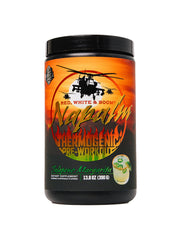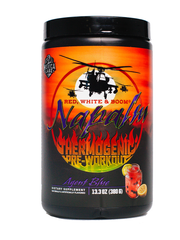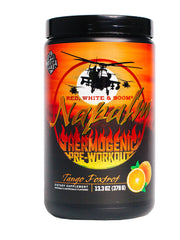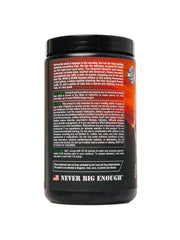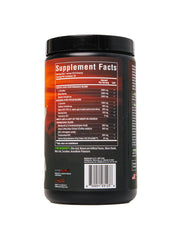
- Cocoabuterol® - has been shown to reduce oxidative stress on the body as well as have beneficial factors on fat loss, muscle hypertrophy, and insulin sensitivity.
- Mitoburn™ - can increase conversion of white adipose tissue to brown adipose tissue, thus increasing fatty acid oxidation, improved insulin sensitivity.
- ProGBB™ - can boost L-Carnitine concentration in the body, which plays a key role in energy production by its ability to transport fatty acids into the mitochondria to be used as energy.
We love the smell of Napalm in the morning. But not the flesh-melting, incinerate-everything kind. We like the delicious, so-good-it’ll-make-you-fist-fight-your-aunt kind. The targeted-lipolysis-and-energy-production-formula kind, stuffed into America’s-finest-pre-workout-powdered-juju-with-a-side-of-karate-chopping-you-in-the-neck kind. Red, White & BOOM Napalm Edition is like putting firecrackers, a fried turkey, a stereo system blasting the Star-Spangled Banner, reality TV, and a gallon of cola into a barrel and lighting it on fire. Yeah, it’s that good.
† These statements have not been evaluated by the Food and Drug Administration. This product is not intended to diagnore, treat, cure, or prevent any diseases.
Karate-Chop Performance Blend
L-Citrulline
Citrulline is a non-essential, non-protein amino acid that forms during the urea cycle and forms ornithine when combined with carbon dioxide. Citrulline is also a critical source of endogenous (natural) arginine, as it is rapidly and efficiently converted to arginine in the vascular endothelium and other tissues.
Citrulline’s benefits have been shown to be greater than its parent compound. While arginine undergoes direct hepatic (liver) metabolism through the enzyme arginase, citrulline bypasses hepatic metabolism entirely and it is delivered straight to the bloodstream. The result is that gut absorption and plasma (blood) bioavailability studies comparing citrulline and arginine have shown two things. First, that citrulline is less readily destroyed and has greater absorption than arginine. Second, that citrulline supplementation increases arginine levels more effectively than arginine supplementation itself.
This translates to promising results. For example, animal studies show a significant increase in anaerobic performance at a 250mg/kg/day serving of citrulline, while studies in humans implicate citrulline in both aerobic and anaerobic performance increases. As a critical part of the urea cycle, citrulline’s performance benefits are thought to be a result of its role in ammonia clearance. Citrulline is implicated in reducing the oxygen cost of muscle processes, along with increasing the rate of post-exercise ATP and phosphocreatine replenishment. As ATP and phosphocreatine are the body’s ‘exercise fuel,’ this may result in citrulline delaying time to exhaustion in aerobic and anaerobic exercise.
Beta Alanine
Carnosine is a bit of an odd duck: we know that it is crucial for muscle function, and that dietary sources of carnosine are essential, but we do not know precisely how it is working. Moreover, for decades, we had no idea how to increase intramuscular concentrations, as exogenous carnosine sources degraded in the body so fast as to be effectively useless.
Enter beta-alanine. Simply a different iteration of one of the amino acids that comprises carnosine itself (alanine), beta-alanine has proven to be the most effective means of significantly increasing intramuscular concentrations of carnosine – and therefore of promoting all of carnosine’s various beneficial effects on muscle performance. If that were not enough, beta-alanine has also demonstrated beneficial physiological effects independent of its parent compound. To understand why, though, we need to first understand some of the basics behind carnosine itself.
Carnosine, a cytoplasmic dipeptide synthesized from the precursors L-histidine and l-alanine, is present in high concentrations in skeletal muscle and plays a pivotal role as a, “chemical buffer” in myocytes (muscle cells). It has long been known that carnosine concentrations are highest in glycolytic, rather than oxidative muscle fibers (roughly speaking, explosive vs., endurance muscle fibers, respectively), and thus long hypothesized that this amino acid is required for sustained performance during supramaximal exercise.
Carnosine, a cytoplasmic dipeptide synthesized from the precursors L-histidine and l-alanine, is present in high concentrations in skeletal muscle and plays a pivotal role as a, “chemical buffer” in myocytes (muscle cells). It has long been known that carnosine concentrations are highest in glycolytic, rather than oxidative muscle fibers (roughly speaking, explosive vs., endurance muscle fibers, respectively), and thus long hypothesized that this amino acid is required for sustained performance during supramaximal exercise. Recent research demonstrates that carnosine exerts its physiological effects in long hypoxic (low oxygen) drives by functioning as a high-capacity pH buffer in skeletal muscle, preventing the pH ratio of plasma from dropping too low – and therefore preventing crucial pH-dependent processes such as protein synthesis from being inhibited by acidosis.
Despite its critical role in skeletal muscle anaerobic performance, intramyocellular synthesis of carnosine is rate-limited by the availability of l-alanine. Unfortunately, the majority of literature demonstrates that attempting to increase intramuscular levels of carnosine via either direct carnosine or alanine supplementation is largely ineffective due to carnosine/alanine pharmacokinetics. Enter beta-alanine. Research with beta-alanine demonstrates consistent and dose-dependent increases to intramuscular carnosine concentrations with beta-alanine supplementation, with certain studies showing an increase of 40-60% with chronic administration. These same literatures reveal a synergistic effect of exercise on beta-alanine supplementation, whereby the muscle adaptive changes associated with resistance training promote further intramuscular carnosine production in response to beta-alanine supplementation.
In simpler language, this essentially means that beta-alanine is a dietary supplement that promotes its own effects in combination with exercise. As you exercise, you simultaneously intensify beta-alanine’s physiological actions – both directly, as well as in the production of intramuscular carnosine. Once ingested, beta-alanine’s exercise-specific beneficial activity is well-established. Elevation of intramuscular carnosine content via beta-alanine supplementation has been shown to improve performance in the following ways.
- Both acute and chronic increases in total work capacity, measured by total volume during exercise sessions.
- Highly significant increases to TTE (total time to exhaustion), one of the most accurate and comprehensive measures of endurance. In various trials, beta-alanine supplementation has been shown to increase TTE by upwards of 20%.
Increases to total muscle power output in both acute and chronic trials, suggesting that beta-alanine’s most significant benefit is to those engaging in power-dependent resistance training.
In total, a significant body of research exists to suggest that beta-alanine may significantly increase muscle power output, strength, training volume and output, overall performance in hypoxic (oxygen-deprived) conditions and peak VO2 max (oxygen holding capacity).
These myriad benefits make beta-alanine both one of the most-studied, and most well-rounded dietary supplements. Beta-alanine not only has direct, actionable physiological effects, but also promotes critical muscle physiologic adaptations that promote its own effects.
Betaine Anhydrous
Betaine (trimethyl glycine) is found naturally in most living organisms. It is well known to protect non-mammalian animal life in conditions of osmotic stress (a rapid change in the amount of solute surrounding a cell), in addition to functioning as an osmolyte in mammalian (including human) tissues. Betaine is formed in cells as an oxidation product of choline and can be obtained in the diet from foods such as spinach and beets.
Though data on betaine is limited, and recent, the available literature suggests that this compound may have effects in a few areas. Studies on betaine using servings as little as 1.25g/day and up to 5g/day for up to 14 days have shown promising results. In one study, a 2.5g/day serving was found to enhance endurance and total repetition volume for the squat, bench press, and jump squat in in healthy-exercised trained adults. A similar study using the same serving found that betaine use increased peak power and maximum peak power, along with force and the maintenance of both force and power in healthy, exercise-trained subjects.
Perhaps more interesting, however, is a study which examined betaine’s effect on the endocrine system. This study revealed that betaine may exert an effect on several endocrine processes given the proper conditions, causing the authors to hypothesize that long(er) term betaine supplementation may increase the hypertrophic response to resistance training.
Bleeding-Eyes Focus Blend
L-Tyrosine
Tyrosine is amongst a class of amino acids known as ‘non-essential’ amino acids, so called because the body can produce them endogenously, and it is therefore not essential to consume dietary tyrosine. That said, tyrosine is also what is known as a conditionally-essential amino acid; conditionally-essential because, along with glucose and ammonia, the synthesis of tyrosine additionally requires adequate levels of phenylalanine. Once synthesized, tyrosine is one of the most critical amino acids, given its prominent role as a substrate in the synthesis of the catecholamines dopamine, norepinephrine, and epinephrine, in addition to both T3 (triiodothyronine) and T4 (thyroxine) thyroid hormones.
In studies on stress modulation, tyrosine has been demonstrated to reverse stress-induced norepinephrine depletion and the depressant-behavioral effects normally associated with it. In simpler terms, tyrosine may, in certain conditions, dampen the extent to which norepinephrine is removed from the bloodstream during a stress event. In simpler terms still, tyrosine may help to mitigate the sense of depletion and fatigue felt at the end of a workout.
Tyrosine may also play important metabolic functions, mostly related to its role in synthesizing compounds which stimulate the nervous system. While not traditionally considered a sympathomimetic amine, studies which have co-administered tyrosine and stimulants demonstrate a synergistic effect. These studies suggest that tyrosine may potentiate the effects of both endogenous and supplemental norepinephrine and its mimetics (in the case of exogenous use) with respect to lipolysis, thermogenesis, and energy expenditure. Meaning that tyrosine may play a role in assisting norepinephrine to break up triglycerides and increase body heat transiently.
Caffeine Anhydrous
Caffeine is one of the most widely consumed, and perhaps one of the most reviewed, psychoactive compounds. Its physiological effects in a range of areas have been well-documented, including exercise performance, information processing, alertness and mood enhancement, attention, and awareness, along with its anti-lipogenic and lipolytic abilities.
Most importantly to NAPALM, caffeine has been shown to have significant effects on exercise performance, even with ingestion in servings as small 3 to 9mg/kg/bw/day (the equivalent of 2 cups of standard coffee, for a 170lb male). In endurance training, possible explanations for caffeine’s performance-enhancing effects lie in its metabolic effects on both lean and fat tissue. It is suggested that caffeine’s potent lipolytic (the breakdown of fat tissue into fatty acids) and oxidative (the actual ‘burning’ of fat) action allow the body to utilize these sources during prolonged submaximal exercise. Consequently, muscle glycogen is spared and available for use later in the training session. Practically speaking, this means caffeine is forcing your body to preferentially use fat tissue as a fuel source, while sparing the glycogen which gives you the full-bodied look!
In short-term exercise, caffeine’s demonstrated role in the inhibition of cyclic AMP- phosphodiesterase’s (PDE), adenosine receptor antagonism, and adrenoreceptor agonism come into play. These three pathways collectively stimulate lipolytic activity, boost fat metabolism, increase metabolic rate and energy expenditure, and regulate the body’s thermogenic activity. The practical results of activating these pathways are increases to the contractile force of both cardiac and skeletal muscle (harder flexion), an increase in energy expenditure (freeing up more caloric energy to be used in contraction), dilation of vasculature (better blood flow), and improvements to both nitrogen retention and skeletal muscle protein synthesis (key components to muscle building).
Alpha-GPC 50% (L-alpha glycerylphosphorylcholine)
Of the known choline pro-drugs or precursors, Alpha GPC appears to have exert the greatest influence on circulating choline levels. Choline is an essential nutrient involved in numerous metabolic pathways, including DNA regulation and repair, protein function, and metabolism. Perhaps most importantly, the critical neurotransmitter acetylcholine is produced directly from free choline via cholinergic neurons. Acetylcholine is then responsible for several functions itself, most crucially as the compound which induces muscular contraction, and as the neuromodulator partially responsible for modulating risk/reward, arousal, and enhancing memory.
Choline’s essential role as a substrate for acetylcholine, and therefore brain development, is well documented in animal models. These studies demonstrate that levels of free maternal choline have a direct and fundamental impact on prenatal brain development, with the enhancements or deficits lasting into adulthood. Choline’s enhancing effect is particularly prominent in the hippocampus. In humans, the hippocampus is primarily involved in the consolidation of memory (taking short, episodic memory and translating it into long-term memory) and the learning of new information. Acetylcholine is a critical component in these processes, as mentioned above, and choline may therefore play a potential role in these processes as well by providing the substrate for acetylcholine synthesis.
Whether through these, or other independent mechanisms, a recent trial using Alpha GPC demonstrated a statistically significant increase to power output. In a placebo-controlled, double-blind, randomized trial, 14 healthy volunteers, split into an Alpha GPC or placebo group, were tested on various exercises. In comparison to the placebo group, the Alpha GPC group experienced a 14% increase to bench press. The researchers hypothesize that the peak power increase was the result of a substantial acute increase to growth hormone, one of the observed effects of Alpha GPC supplementation.
Halostachine
Halostachine is a natural alkaloid extracted from Halostachys caspica and Halostachys belangeriana, which is structurally like the alkaloid ephedrine and synephrine. It is also structurally like neurotransmitters such as dopamine, norepinephrine, and epinephrine. As a beta-agonist, halostachine’s range of benefits can include:
- lipid oxidation
- increasing heart rate
- enhanced focus
- increasing exercise induced thermogenesis
- aids glucose storage and utilization
This range of benefits can make halostachine a powerful addition to any preworkout supplement, making its addition to a powerhouse formula, like NAPALM, a no-brainer!
Yohimbine HCl
Extracts or preparation of Pausinystalia yohimbe, and related sub-species, have been used in traditional and folk medicinal systems such as Ayurveda and Unani for centuries. More recently, the principal bioactive compound in Pausinystalia yohimbe, both as a whole plant, and its extracted components, has been the subject of numerous clinical trials investigating its various physiological pathways.
In particular, recent research has shown that yohimbine exerts a powerful pre-synaptic inhibiting effect on alpha-adrenergic receptors – making it a potent adrenergic antagonist. This effect seems to be localized and largely specific to adipocytes, attaching to their adrenergic receptor sites and preventing them from receiving the catecholamines (norepinephrine and epinephrine) that would normally initiate growth signals.
While limited, there is some evidence in human, clinical trials to suggest that Yohimbine’s postulated mechanisms of action translate into practical effects. In a placebo-controlled trial involving 20 healthy, lean soccer players, subjects were given 20 mg/day in two equal servings, for 21 days. At 21 days, the Yohimbine group reflected small but significant reductions in both total fat mass and body fat percentage as compared to controls – at least partially suggesting that Yohimbine may have a plausible role in combination with diet and exercise in weight management.
Sweat-Like-A-Lady-Of-The-Night-In-Church Thermogenic Blend
MitoBurn® (L- β -Aminoisobutyric Acid)
In recent studies, MitoBurn® (L-BAIBA), a metabolite of L-valine, can stimulate certain “exercise factors” that are released from skeletal muscle in response to muscular stress, in particular muscle contraction. L-BAIBA, a powerful myokine, plays a role in the benefits of regular exercise and begins a positive sequence of events, some of which include increased fatty acid oxidation, improved glucose uptake, and reduced fat mass. Although L-BAIBA primarily works to initiate the “browning” of adipose tissue, it also has been shown to decrease the “beiging” of adipose tissue. This beiging process is when the body reverses the preferred adipose tissue color of brown (high energy usage) back to white (high energy storage). Although most studies have been completed in rats, some results that have been obtained in cell culture models and human cohorts and shown a novel function to support L-BAIBA’s involvement in regulation of carbohydrate and lipid metabolism. These studies also support that L-BAIBA primarily exhibits its benefits in conjunction with physical activity. This is shown from skeletal muscle myokines (peptides) that play an important role is the processes listed above. These myokines are produced, expressed, and released by muscle fibers when under forceable contractions and exert both local and pleiotropic effects. Myokines also help to configure the immune-metabolic factor interactions and health promoting effects of physical exercise that stimulate the communication between skeletal muscle and adipose tissue. Adipose tissue itself will release proinflammatory cytokines in response to inactivity and can be a leading reason for the development of metabolic diseases.
This supported research of MitoBurn® (L-BAIBA) and its benefits show that through its myokine activity and communication through physical activity as well as its ability to aid in the browning of adipose tissue, lead it to be a proposed beneficial intervention for the purposes of body composition improvements.
Green Coffee Bean Extract (Coffea arabica) (50% chlorogenic acids)
Chlorogenic acids are phenolic compounds created during the metabolism of various isoquinic acids found in the leaves of both coffee and tea. In addition to the well-established sympathomimetic effects of coffee and tea’s constituents, recent research has demonstrated a range of other potential benefits for compounds such as chlorogenic acids.
Recent literature suggests that the consumption of both green coffee, as well as standardized extracts of CGAs, relax the vasculature and improve vasoreactivity, impose an inhibitory effect on lipid accumulation and body weight in both mice and humans, and modulate glucose metabolism via the glucose-6-phosphate pathway.
Trials in both humans and mice using 1% extracts of green coffee bean revealed significant bodyweight reductions over periods of two and eight weeks. Researchers hypothesized that the bodyweight reductions associated with oral CGA administration was associated with the product’s numerous mechanisms of action, rather than a single, isolated cause.
Theobromine HCl
Theobromine, one of the main methylxanthine compounds found in cocoa is primarily effective in the increase of nitric oxide to in the blood stream, which is beneficial to produce the “pump” when ingested pre-workout. Another reaction that can be seen with theobromine is dilation of blood vessels. This can increase blood flow during vigorous exercise leading to increased time to exhaustion but also can pose benefits to individuals who suffer from high blood pressure. Theobromine also has a very high bioavailability and ability to stay in the body for extended periods of time (7-8 hours). Several studies have also looked at the effects of theobromine on human subjects and results have shown its ability to reduce oxidative stress on cells and regulation of gene expression.
Gamma Butyrobetaine Ethyl Ester HCl (ProGBB™)
NAPALM is using the trademarked form of Gamma Butyrobetaine Ethyl Ester HCL, or GBB for short, Pro-GBB™. GBB is a naturally occurring molecule in the body that aids in the boosting of the non-essential amino acid L-carnitine. L-carnitine plays a key role in energy production by its ability to transport fatty acids into the cell’s mitochondria (‘energy producing powerhouse’) to be used for energy. Studies have shown that when GBB is present it can increase the bodies L-carnitine supply, thus providing enhanced benefits. So, in simplified terms, GBB increases usable L-carnitine in the body which increases the mitochondria’s ability to use fatty acids for energy. With the goal of reducing body fat or even improving performance, L-carnitine shows benefits in this field. A study conducted on mammals looked at the responses of L-carnitine supplementation on growth performance as well as circumference measurements. The results showed that weights of muscle tissue increased, whereas abdominal fat percentage decreased.















